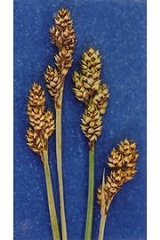
Carex praeceptorum
Encyclopedia
Carex praeceptorum is a species of sedge
known by the common names early sedge and teacher's sedge. It is native to much of western North America, from British Columbia
to California
to Colorado
, where it grows in wet, marshy habitat such as bog
s and lakeshores. This sedge produces small clumps of short, grasslike stems 10 to 30 centimeters tall from a thin network of rhizome
s. The thin, grayish to pale green leaves are up to about 15 centimeters in length but shorter than the stems. The inflorescence
is a small, dense bundle of a few brown flower spikes. The fruit is coated in a dark colored perigynium.
Carex
Carex is a genus of plants in the family Cyperaceae, commonly known as sedges. Other members of the Cyperaceae family are also called sedges, however those of genus Carex may be called "true" sedges, and it is the most species-rich genus in the family. The study of Carex is known as...
known by the common names early sedge and teacher's sedge. It is native to much of western North America, from British Columbia
British Columbia
British Columbia is the westernmost of Canada's provinces and is known for its natural beauty, as reflected in its Latin motto, Splendor sine occasu . Its name was chosen by Queen Victoria in 1858...
to California
California
California is a state located on the West Coast of the United States. It is by far the most populous U.S. state, and the third-largest by land area...
to Colorado
Colorado
Colorado is a U.S. state that encompasses much of the Rocky Mountains as well as the northeastern portion of the Colorado Plateau and the western edge of the Great Plains...
, where it grows in wet, marshy habitat such as bog
Bog
A bog, quagmire or mire is a wetland that accumulates acidic peat, a deposit of dead plant material—often mosses or, in Arctic climates, lichens....
s and lakeshores. This sedge produces small clumps of short, grasslike stems 10 to 30 centimeters tall from a thin network of rhizome
Rhizome
In botany and dendrology, a rhizome is a characteristically horizontal stem of a plant that is usually found underground, often sending out roots and shoots from its nodes...
s. The thin, grayish to pale green leaves are up to about 15 centimeters in length but shorter than the stems. The inflorescence
Inflorescence
An inflorescence is a group or cluster of flowers arranged on a stem that is composed of a main branch or a complicated arrangement of branches. Strictly, it is the part of the shoot of seed plants where flowers are formed and which is accordingly modified...
is a small, dense bundle of a few brown flower spikes. The fruit is coated in a dark colored perigynium.

